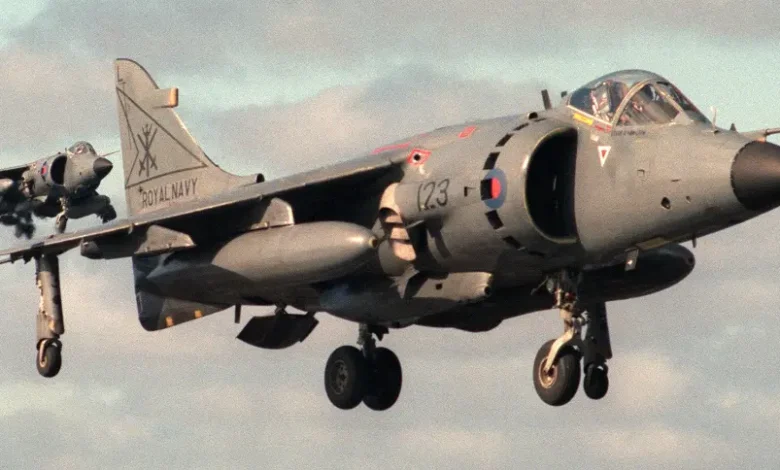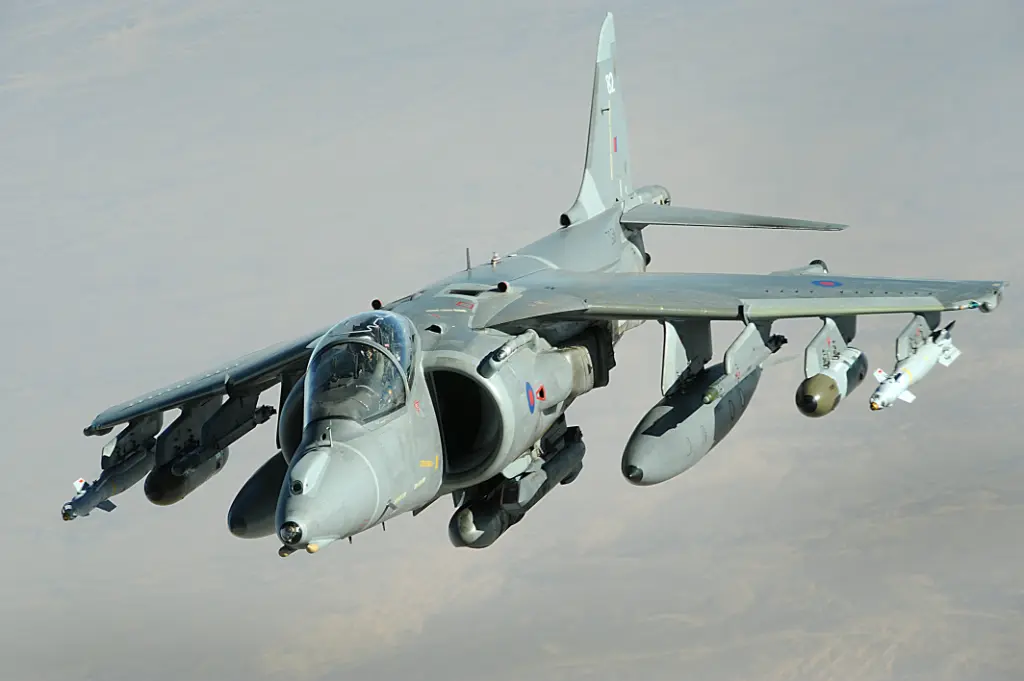British Aerospace Sea Harrier

The British Aerospace Sea Harrier is a naval short takeoff and vertical landing (STOVL) fighter aircraft developed by British Aerospace for the Royal Navy. First flown in 1978 and introduced in 1980, the Sea Harrier was designed for air defense, reconnaissance, and ground-attack missions. Known for its unique vertical/short takeoff and landing capabilities, the Sea Harrier played a critical role in the Falklands War and other conflicts.
Fact Sheet
| Role | Naval STOVL fighter |
|---|---|
| Manufacturer | British Aerospace |
| First Flight | 1978 |
| Service Entry | 1980 |
| Crew | 1 |
Specifications
| Length | 14.17 m (46 ft 6 in) |
|---|---|
| Wingspan | 7.7 m (25 ft 3 in) |
| Height | 3.71 m (12 ft 2 in) |
| Empty Weight | 6,700 kg (14,770 lb) |
| Max Takeoff Weight | 11,884 kg (26,200 lb) |
| Powerplant | 1 × Rolls-Royce Pegasus 104 turbofan |
| Thrust | 21,750 lbf (96.7 kN) |
| Max Speed | Mach 0.9 (1,065 km/h; 662 mph) |
| Service Ceiling | 15,240 m (50,000 ft) |
| Range | 1,000 mi (1,609 km) ferry range |
| Rate of Climb | ~14,700 ft/min (75 m/s) |
Avionics & Armament
| Main Radar | Ferranti Blue Fox radar |
|---|---|
| Avionics | Navigation/attack systems, targeting pods |
| Armament | Two 30-mm ADEN cannons (120 rounds per gun); Up to 4 external hardpoints for: – Air-to-air missiles (AIM-9 Sidewinder) – Air-to-ground munitions (bombs, rockets) – External fuel tanks |
Notable Features
- STOVL capability for operations from aircraft carriers and short runways.
- Proven combat record in the Falklands War.
- Compact design for naval operations.
- Multirole capability for air defense and ground attack.
- Retired from Royal Navy service in 2006.

British Aerospace Sea Harrier: The Iconic STOVL Naval Jet
The British Aerospace Sea Harrier is a renowned naval short take-off and vertical landing (STOVL) / vertical take-off and landing (VTOL) strike fighter. Famous for its unique operational capabilities, it played a pivotal role in the Falklands War. It was specifically developed for the Royal Navy’s smaller aircraft carriers.
Sea Harrier Origins: V/STOL for the Royal Navy
The Sea Harrier’s development emerged from the success of the land-based Hawker Siddeley Harrier. The Royal Navy required an air defense and reconnaissance aircraft capable of operating from its smaller “through-deck cruisers” (aircraft carriers like HMS Invincible), without the need for traditional catapults or arrestor gear. The Sea Harrier FRS.1 (Fighter, Reconnaissance, Strike) first flew in August 1978 and entered Royal Navy service in 1980.
Sea Harrier Core Capabilities: Vectored Thrust & Air Superiority
The Sea Harrier’s defining characteristic was its V/STOL capability, powered by a single Rolls-Royce Pegasus vectored-thrust turbofan engine. This allowed vertical take-offs and landings, as well as short take-offs (STOs) using a ski-jump ramp (significantly increasing payload and fuel). The FRS.1 variant was initially conceived as an air defense fighter for the fleet, featuring an elevated bubble canopy for improved visibility in air combat and carrier operations.
Sea Harrier Armament & Radar: AIM-9L & Blue Fox
The Sea Harrier FRS.1 was equipped with the Ferranti Blue Fox pulse-doppler radar, providing crucial beyond-visual-range (BVR) capabilities and maritime targeting. Its primary air-to-air weapon was the AIM-9L Sidewinder infrared-guided missile, famed for its all-aspect attack capability. For ground attack, it could carry two 30mm ADEN cannon pods and unguided rockets.
Key Sea Harrier Variants: FA.2 & Blue Vixen Radar
- Sea Harrier FRS.1: The initial production version for the Royal Navy (57 built for UK, 23 FRS.51 export variant for India).
- Sea Harrier FA.2: A significant mid-life upgrade in the 1990s, enhancing its air-to-air capabilities. Key improvements included the much more advanced Ferranti (later BAE Systems) Blue Vixen pulse-doppler radar, considered highly capable for its time with multi-target tracking. The FA.2 was also the first non-US aircraft to integrate and fire the AIM-120 AMRAAM (Advanced Medium-Range Air-to-Air Missile), providing formidable BVR capability. It also featured a more powerful Pegasus Mk 106 engine.
Sea Harrier Combat Record: Falklands War Legend
The Sea Harrier achieved legendary status during the 1982 Falklands War. Operating in limited numbers (20 FRS.1s), it became the sole fixed-wing fighter for the British Task Force, providing vital air defense against Argentine air attacks. Sea Harrier pilots achieved 21 confirmed air-to-air kills against Argentine aircraft (Mirages, Daggers, Skyhawks) with zero air-to-air losses. This success was due to pilot skill, the all-aspect AIM-9L Sidewinder, and the Sea Harrier’s unique VIFF (Vectoring In Forward Flight) agility. Beyond the Falklands, FA.2s participated in Bosnian (1995) and Kosovo (1999) operations.
Sea Harrier Retirement & Enduring Legacy
The Royal Navy controversially retired its Sea Harriers (both FRS.1s and FA.2s) in March 2006, citing budget cuts and a shift towards the Harrier GR.7/GR.9 and the future F-35B. The Indian Navy operated its Sea Harriers (FRS.51 and upgraded variants) until their final retirement in 2016, replaced by the MiG-29K.
As of mid-2025, the original British Aerospace Sea Harrier variants are fully retired from military service worldwide. Only a handful remain as museum exhibits. Its V/STOL legacy continues through the AV-8B Harrier II, still operated by the US Marine Corps, Italian Navy, and Spanish Navy. The Sea Harrier remains an iconic symbol of ingenuity, resilience, and tactical effectiveness in naval aviation history.



